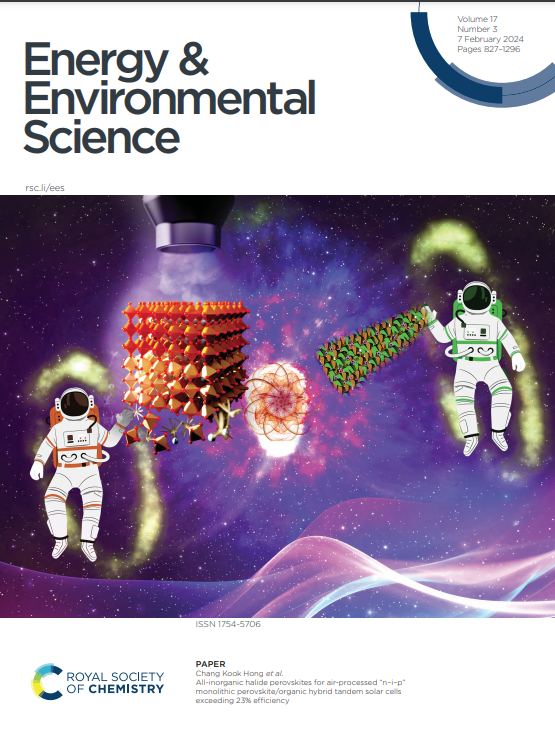Interfacial Ionic and Thermal Regulation for Highly Reversible and Ultra-Reliable Zinc-Ion Batteries
IF 32.4
1区 材料科学
Q1 CHEMISTRY, MULTIDISCIPLINARY
引用次数: 0
Abstract
Prevalent glass fiber separators in aqueous Zn-ion batteries (ZIBs) offer inadequate control over interfacial reactions, contributing to the rapid growth of Zn dendrites and aggravated parasitic reactions. Moreover, the stability of ZIBs under extreme operating conditions remains a critical yet often overlooked issue. Here, we present a novel silane-decorated glass fiber separator with engineered physical structures and surface chemistry, facilitating highly reversible and ultra-reliable ZIBs. Silane strengthens the separator, resists stress, and forms heat-insulating char layers under flame, ensuring reliability in extreme conditions. Silane networks also function as fillers that enhance pore uniformity for even Zn2+ flux. The amino groups in silane demonstrate comprehensive management of interfacial anions, cations, water transfer and reaction kinetics. This capability induces Zn2+ to concentrate at the interface, accelerates Zn2+ transfer, reduces deposition barriers, and obstructs water molecules and sulfate ions from participating in parasitic reactions. Consequently, dendrite-free Zn plating/stripping is achieved with 99.4% Coulombic efficiency over 250 cycles, stable charge/discharge performance for 7000 hours, and remarkable cycling stability and flame resistance for Zn//V full batteries. This strategy demonstrates versatility across various separator materials and battery chemistry, offering a promising route to more reliable and higher-performing energy storage systems.高可逆和超可靠锌离子电池的界面离子和热调节
常用的玻璃纤维隔膜对界面反应控制不足,导致锌枝晶生长迅速,寄生反应加剧。此外,zbs在极端工作条件下的稳定性仍然是一个关键但经常被忽视的问题。在这里,我们提出了一种新型的硅烷装饰玻璃纤维分离器,具有工程物理结构和表面化学,可实现高度可逆和超可靠的zib。硅烷增强分离器,抵抗应力,并在火焰下形成隔热炭层,确保在极端条件下的可靠性。硅烷网络还可以作为填料,增强均匀的Zn2+通量的孔隙均匀性。硅烷中的氨基表现出对界面阴离子、阳离子、水转移和反应动力学的综合管理。这种能力诱导Zn2+在界面处集中,加速了Zn2+的转移,降低了沉积障碍,阻碍了水分子和硫酸盐离子参与寄生反应。结果表明,在250次循环中,无枝晶镀/剥离锌的库仑效率达到99.4%,充放电性能稳定7000小时,并具有显著的循环稳定性和耐燃性。该策略证明了各种隔膜材料和电池化学的多功能性,为更可靠、性能更高的储能系统提供了一条有希望的途径。
本文章由计算机程序翻译,如有差异,请以英文原文为准。
求助全文
约1分钟内获得全文
求助全文
来源期刊

Energy & Environmental Science
化学-工程:化工
CiteScore
50.50
自引率
2.20%
发文量
349
审稿时长
2.2 months
期刊介绍:
Energy & Environmental Science, a peer-reviewed scientific journal, publishes original research and review articles covering interdisciplinary topics in the (bio)chemical and (bio)physical sciences, as well as chemical engineering disciplines. Published monthly by the Royal Society of Chemistry (RSC), a not-for-profit publisher, Energy & Environmental Science is recognized as a leading journal. It boasts an impressive impact factor of 8.500 as of 2009, ranking 8th among 140 journals in the category "Chemistry, Multidisciplinary," second among 71 journals in "Energy & Fuels," second among 128 journals in "Engineering, Chemical," and first among 181 scientific journals in "Environmental Sciences."
Energy & Environmental Science publishes various types of articles, including Research Papers (original scientific work), Review Articles, Perspectives, and Minireviews (feature review-type articles of broad interest), Communications (original scientific work of an urgent nature), Opinions (personal, often speculative viewpoints or hypotheses on current topics), and Analysis Articles (in-depth examination of energy-related issues).
 求助内容:
求助内容: 应助结果提醒方式:
应助结果提醒方式:


